Quick Information Source¶
This page deals with Quick Information Source related functionality.
Disclaimer¶
Note: The Quick Information Source functionality only supports online access, meaning that no data mart related access views or snapshot table functionality is supported.
Draft a Quick Information Source¶
In order to create a Quick Information Source it is necessary to first create a draft. This is handled in the page.

By selecting the Draft Quick Information Source command, an assistant will be launched.
Start by specifying if the source should be an ordinary LU view or an IAL view.
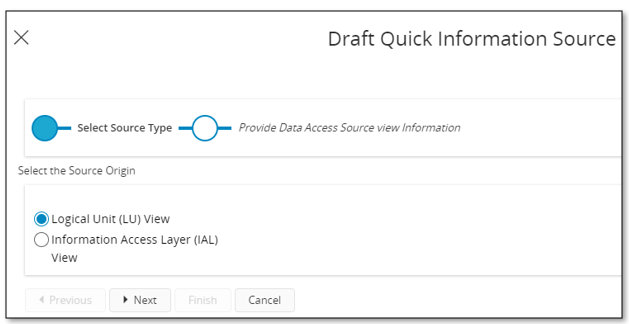
| Section/Attribute | Description |
|---|---|
Select the Source Origin
|
Specify the source for the Quick Information Source Draft. Either an ordinary LU view or an IAL view. |
Next step will be to provide Logical Unit/IAL Information and some Quick Information Source details.
- If source is Logical Unit (LU) View
- Supply Logical Unit Information, i.e. Module, LU Name, View Name
- Define if new Quick Dimensions should be drafted if possible (based on the source view references)
- Define if dimensions, existing or dimensions to be drafted, should be connected to the Quick Information Source draft.
- If source is Information Access layer (IAL) View
- Supply IAL Information, i.e. View Name.
- Quick Information Source Details
- Quick Information Source ID will be suggested but can be modified.
- The Navigator Folder Name is also suggested but can be modified.
- When all information has been added, use Finish to start the draft creation.
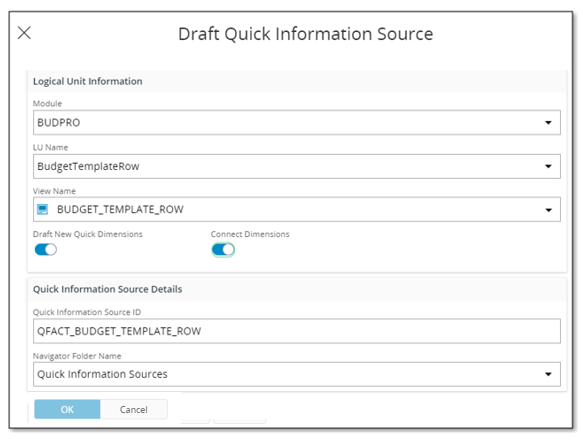
| Section/Attribute | Description |
|---|---|
| Logical Unit Information | Applies if source is Logical Unit (LU) View. Module, LU Name, View Name can be selected from List of Values. If Draft New Quick Dimensions is specified, quick dimensions will, if possible, automatically be drafted when drafting the Information Source. If Connect Dimensions check box is selected, dimensions will be connected to the Quick Information Source Draft. |
| IAL Information | Applies if source is Information Access layer (IAL) View. Supply the IAL view name. List Of Values is available. |
| Quick Information Source ID | ID for the Quick Information Source (QIS) to be drafted. By default the ID is suggested as QFACT_<view_name>. E.g. QFACT_OBJECT_OPERATION. The field is editable. |
| Navigator Folder Name | Defines the name of the folder in the BR Navigator that will contain the Quick Information Source. Note: The folder as well as the created Information Source will be directly available in IFS Business Reporter Default Navigator Folder Name is Quick Information Sources. User can select a navigator name from List of Values or give a new name |
The drafted QIS will be displayed as follows in the page.
The assistant also makes it possible to directly navigate to the (detail) page.

Quick Information Source Details¶
Drafted details can be found in the (detail) page.

| Attribute | Description |
|---|---|
| Quick Information Source | |
| Quick Information Source ID | Quick Information Source ID which is given when drafting an information source via an assistant. |
| Display Name | Name of the QIS displayed in the client navigator |
| Source View Name | Name of the source view |
| Navigator Folder Name | Navigator folder name of the IFS Business Reporter client |
| Created View Name | View name created when drafting/creating a quick information source. |
| Based on IAL View | Defines is the source is an IAL view or not |
| Status | Status of the Quick Information Source; either Drafted or Created |
| Error Status | Defines if error were reported while drafting the Quick Information Source |
| Quick Information Source Items | |
| see separate description | |
| Created View Definition | |
| View definition to be used when creating final source view. | |
| Errors and Warnings | |
| Warnings/Errors | Warnings/Errors generating when drafting a quick information source. These needs to be reviewed before creating the quick information source |
| Initial Warnings/Errors | Warnings/Errors generated from the source view before any processing is done. These are mostly related to the column references. Initial warnings and errors can sometimes be corrected by the processing. |
QIS Item Details¶
The items related to a drafted Quick Information Source can be found in the Quick Information Source Items section in the (detail) page.
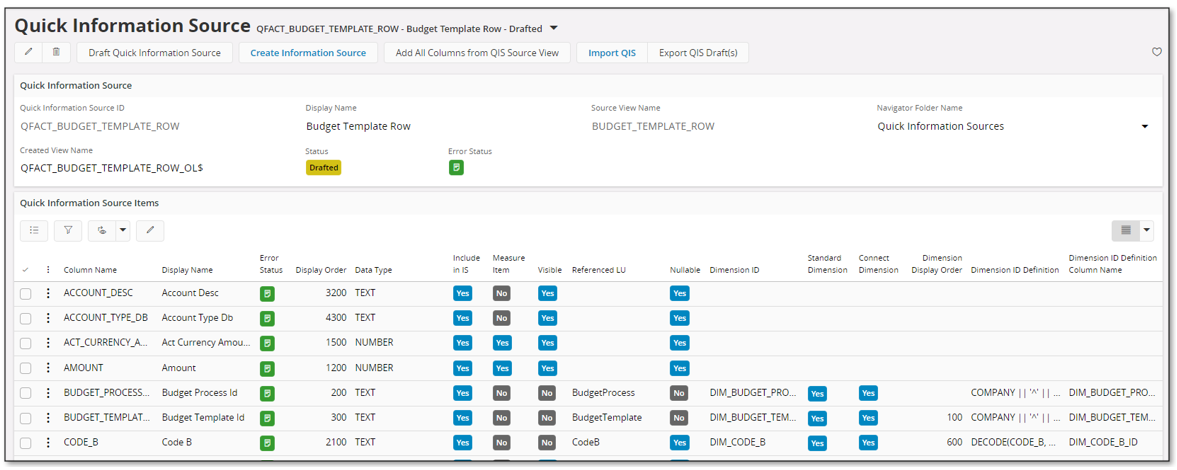
| Attributes | Description |
|---|---|
| Column ID | A unique identification of a column in the source view, selected to be drafted/created in the QIS |
| Display Name | The display name of the item |
| Error Status | Defines if error were reported for this item while drafting the Quick Information Source |
| Display Order | This is the display order of the column in the Information Source navigator in IFS Business Reporter client. The value is set even if the column is or will be marked as not visible. Use this column to modify the display order if the suggested order is not good enough. |
| Data Type | Data type for the column in the dictionary (view definition). This field can be modified. Data types can be DATE, NUMBER, TEXT |
| Include in IS | Indicates if the item should be included in the Information Source. The parent keys, or if a dimension is connected, those columns will be included in the Info Source irrespective of the value of this attribute. |
| Measure Item | Indicates the item is a measure item |
| Visible | Indicates the item is visible in the IFS Business Reporter client |
| Referenced LU | Logical unit/entity reference to which the quick or standard dimension is created/drafted. |
| Nullable | Indicates whether the data returned via the view column can be null or not. Based on the value on this column the Dimension ID Definition will differ if a dimension is connected. |
| Dimension ID | ID of the quick or standard dimension. Quick dimensions will be created only if decided to Draft New Quick Dimension when the draft is ordered or if a Referenced LU is entered without a Dimension ID. |
| Standard Dimension | Indicates that the dimension is a standard dimension |
| Connect Dimension | Indicates if the defined dimensions should be connected to the created Information Source. If decided to Connect Dimensions when the draft is ordered, the dimension will be connected automatically while drafting the QIS. However, user can manually edit this attribute. |
| Dimension Display Order | This is the display order of the dimension in the Information Source navigator in IFS Business Reporter. Use this column to modify the order in which connected dimensions appear in the navigator. |
| Dimension ID Definition | Definition of the dimension ID column used for joining the dimension. Created by concatenating parent keys and column name. |
| Dimension ID Definition Column Name | The name of the dimension ID column. This is a new column that did not exist in the original source view. |
| Parent Keys | Parent Keys of the dimension items |
| Warnings/Errors | Warnings/Errors generating when drafting a quick information source. These needs to be reviewed and corrected before creating the quick information source. |
| Initial Warnings/Errors | Warnings/Errors generated from the source view before any processing is done. These are mainly related to references. Contents of this column will not be modified. User should refer the column Warnings/Errors to find out the warnings/errors for the current state of the Quick Information Source. |
The Dimension ID Definition columns are created automatically but the format of the concatenated keys might not be correct, especially when the involved columns does not have the same data type. It is possible to modify the dimension ID columns. In the Quick Information Source Items section, select a column that has a reference to a dimension, column Dimension ID, and use command Generate Dimension ID. A dialog will open where it is possible to modify the definition of the dimension identity.

All columns involved in creating the dimension ID are presented. It is now possible for each column to select a format Function and also define a Format to be applied for the selected format function. The resulting ID Column Definition will be displayed in the dialog. When OK is pressed, the current definitions in the dialog will be used to create the final definition of the ID column.
Create an Information Source from Selected QIS Draft¶
Use either the Quick Information Sourcesor the Quick Information Source (detail) page.
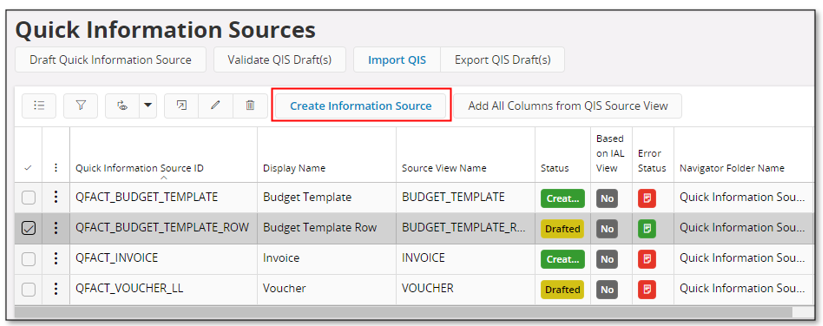
Following steps needs to be followed to create an Information Source from a Draft:
- Select a draft in state Drafted from the list of drafts in the Quick Information Sources page.
- Use the command Create Information Source.
- Only one Information Source can be created.
- If the QIS was successfully created, the status of the Quick Information Source will change from Drafted to Created.
- Created Quick Information Sources will be listed in the Information Sources page.
Delete Selected QIS Draft(s)¶
To delete/remove a QIS draft, use either the Quick Information Sourcesor the Quick Information Source (detail) page.
The status must be Drafted.
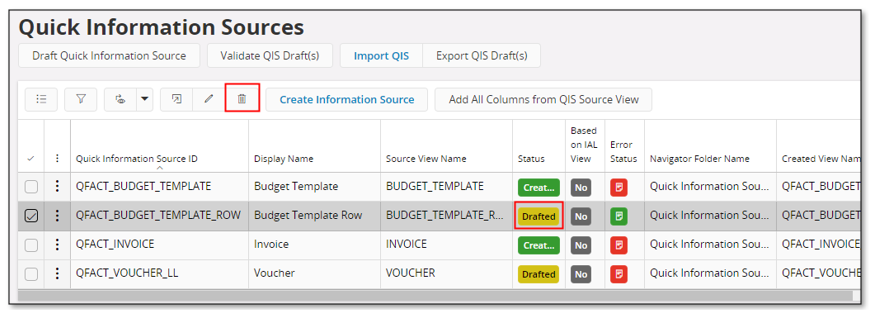
Use standard Delete.
If the status is Created, it is necessary to first remove the Information Source in e.g. the Information Sources page.
Export Selected QIS Draft(s)¶
Quick Information Source draft definitions can be exported and imported.
Export comes in two flavors:
- Export of files to be imported/deployed in the database
- Export of definitions to a XML file that can be imported
To perform export, use the command Export QIS Draft(s).
Export for Import/Deployment in the Database¶
This option can be used to export the metadata and source view related to a Quick Information Source. The metadata file has the extension INS and the view file has the extension APV.
It is required that selected Information Sources are in Created state.
The exported metadata file and source view file can e.g. be used in the following way:
- To be defined in the code handling system as files as a customized Information Source.
If this is the intention, a suggestion is to use the export option Create Folder Structure. - The files can be moved to another environment but it will require that the metadata and view files are manually deployed, since these type of files cannot be imported directly via the IFS Cloud Web client.
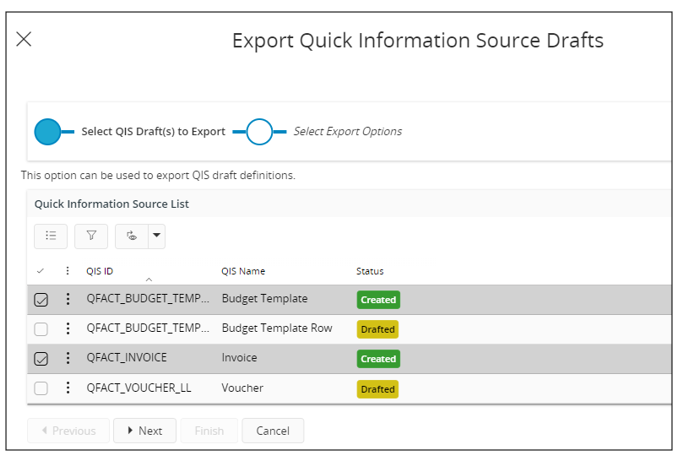
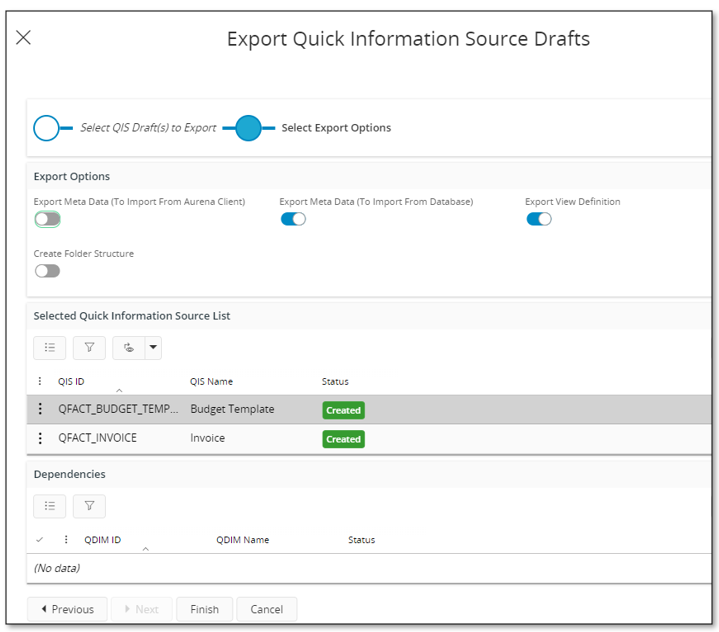
Export for Import via IFS Cloud Web¶
This option can be used to export the Quick Information Source definitions from one environment and then to move it to another environment by importing it via the IFS client.
The selected Information Sources can be in any state. It is only the draft definitions that will be exported.
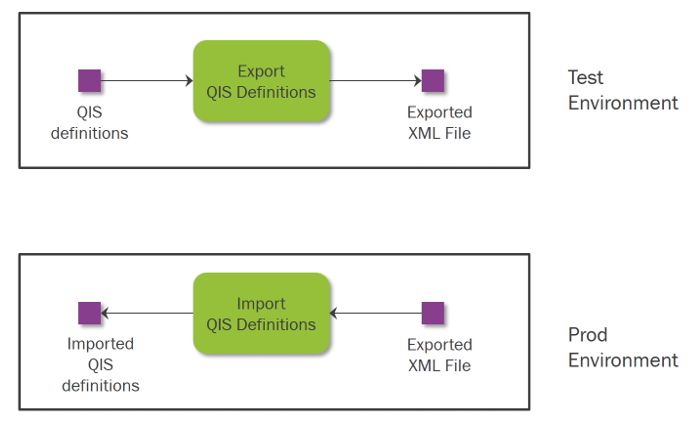
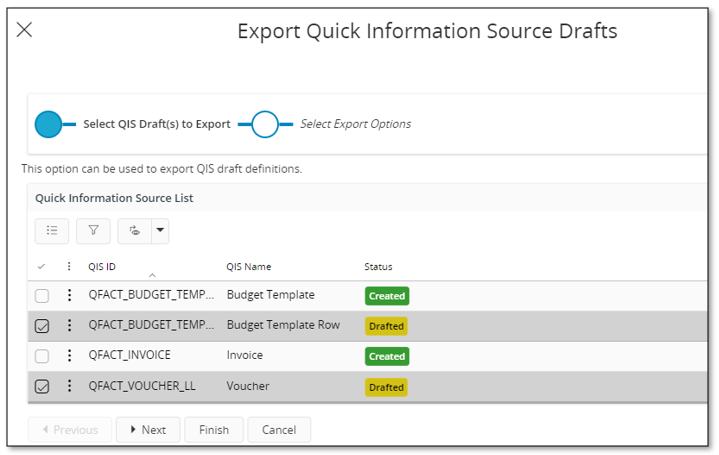
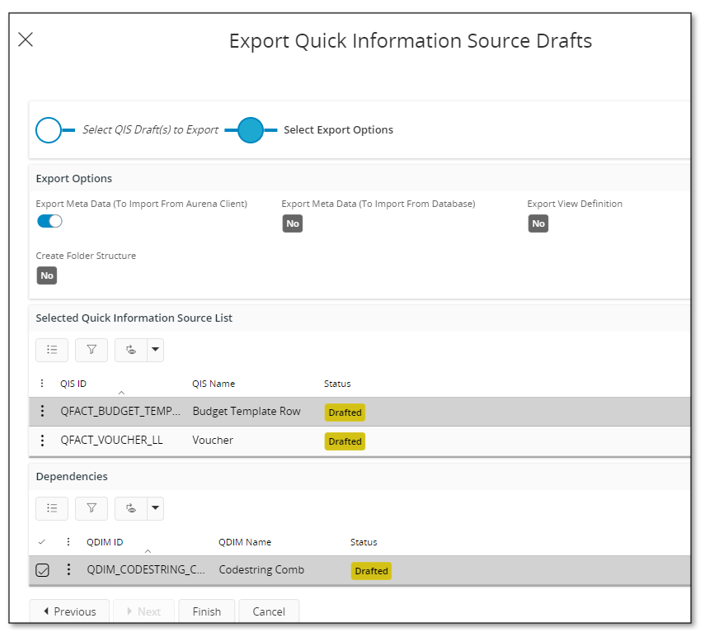
Since only drafts in state Drafted have been selected, the possibility to export the INS file, view file and to export to a folder structure has been disabled.
Export Assistant¶
| Sections/Attributes | Description |
|---|---|
| Quick Information Source List | |
| Lists as available Quick Information Source drafts; selection of drafts to be exported is done here. | |
| Export Options | |
| Export Meta Data (To Import From IFS Cloud Web Client) | Defines if an XML file with draft definitions will be exported for each Quick Information Source or Quick Dimension |
| Export Meta Data (To Import From database) | Defines if a metadata file will be exported for each Quick Information Source or Quick Dimension. Only applicable for drafts in Created state. |
| Export View Definition | Defines if the access view definition of each Quick Information Source or Quick Dimension will be exported. Only applicable for drafts in Created state. |
| Create Folder Structure | Defined if a folder structure should be created when exporting, i.e. suitable for adding files to the code handling system. Only applicable for drafts in Created state. |
| Dependencies | |
| Any dimension that is not selected but has a dependency to the QIS draft or Quick Dimension selected to be exported, will be listed here. User can export these if required. |
Import QIS¶
The Import QIS option can be used to import previously exported QIS draft definitions.
It is only possible to import definitions exported as a XML file. Exported metadata file and/or source view file can not be imported via IFS Cloud Web client.
Import can only be performed if the end user has been granted access to the command ImportQis related to projection QuickInfoSrcHandling.
A typical scenario is:
- Export the draft definitions from a test environment to an XML file
- Import the XML file in another environment, e.g. the production environment
Note: The imported definitions will be in Drafted state
Validate Selected QIS Draft(s)¶
Use the command Validate QIS Draft(s ) to validate the source view to be used to draft the Quick Information Source with the current state of the view. It validates data type and column existence. The validation is handled via an assistant.
Start by selecting the drafts to be validated.
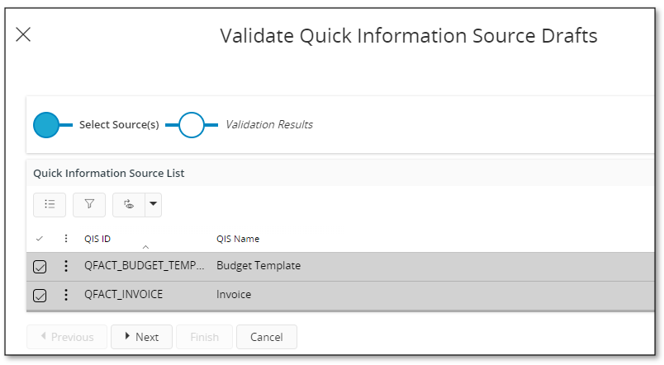
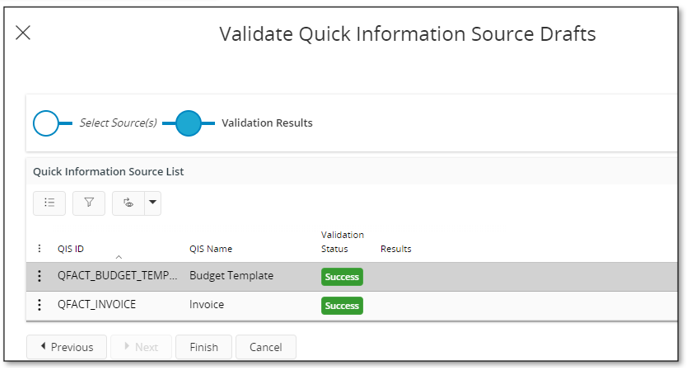
Successfully validated QIS drafts will be listed in the last step of the assistant.
Recreate Selected QIS Database View¶
Select drafts and then use the command Recreate QIS Database View, to recreate the view definition of the selected Information Source.
The following applies:
- QIS based on an IAL view
- The QIS database view can be recreated regardless of state, i.e. both for state Drafted and Created
- QIS based on ordinary core view
- QIS in Drafted state - recreate option is not available
- QIS in Created state - recreate option is available
The recreation will fail if the view associated with the Quick Information Source has been altered by other means. If e.g. the view has been overwritten by an ordinary view definition, it will not be possible to recreate the view, due to that the view must have specific properties to be considered as the source for a Quick Information Source.
Add All Columns from QIS Source View¶
Select drafts and use the command Add All Columns from QIS Source View to add all the columns that were not included when drafting the QIS.
Note: The draft must be in state Drafted to enable addition of new source view columns.
If the source view has changed since it was originally drafted and a Quick Information Source has already been created, then it is necessary to:
- Remove the Information Source in the Information Source page.
- Removing the Information Source leads to that the draft changes state from Created to Drafted.
- Use the Add All Columns from QIS Source View command.
- Modify drafted information.
- Recreate the Quick Information Source.